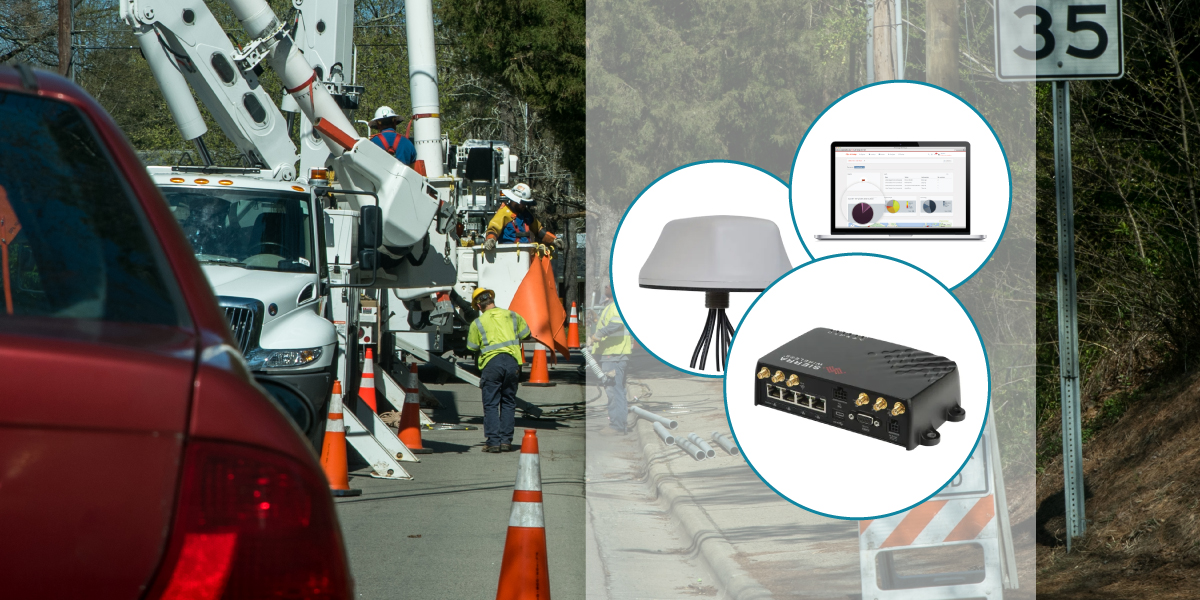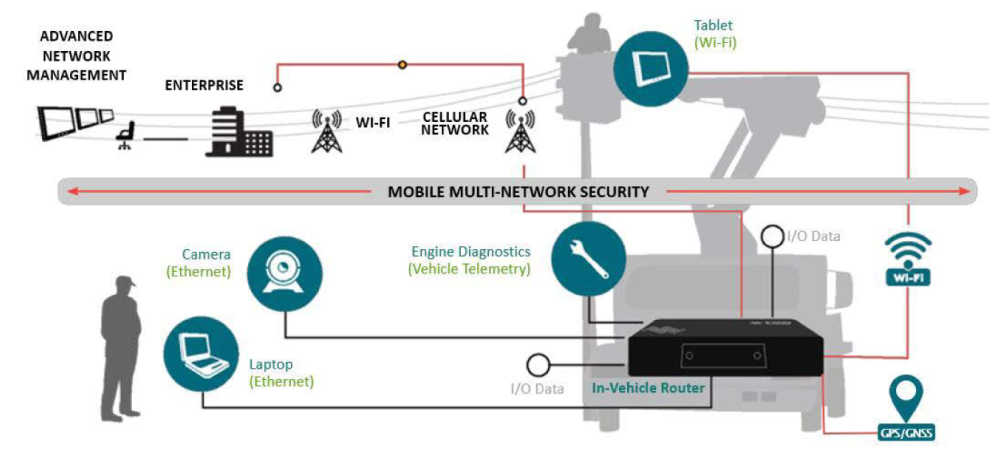Increasing Utility Efficiency With Vehicle Area Networks (VAN)
To enhance customer satisfaction and minimize operational expenses, several utility companies are optimizing their field operations by implementing a vehicle-based cellular networking strategy. By centralizing connectivity through a vehicle area network (VAN), these companies hope to cut costs while boosting field productivity.
Today, utility companies face multifaceted challenges, including meeting consumer expectations, complying with regulatory requirements, addressing aging infrastructure, and maximizing profits. To sustain market agility, utilities must adapt swiftly to change, foster closer customer relationships, intensify their focus on value-added services, and engage in collaborative efforts with diverse partners.
Leaders in the industry are eager to find new initiatives and opportunities that yield maximum returns by mitigating operational expenses, boosting profits, and elevating customer service standards. One impactful investment avenue involves connecting the mobile workforce and vehicles to the enterprise. Many utility organizations have turned to cellular technology for this purpose, leveraging the rapid evolution of cellular networks, particularly with Long-Term Evolution (LTE) technology.
Additionally, mobile workforce management tools have grown in power and sophistication. By implementing a well-crafted strategy to connect the mobile workforce to the enterprise, a substantial opportunity exists for a significant return on investment.
What Is Vehicle Area Networking?
Vehicle networking refers to specialized communication systems that connect the internal components of vehicles and facilitate communication to enhance functionalities like real-time information exchange, location tracking, and accident prevention.

Most vehicles -including cars, buses, and trucks - share common internal components, including Electronic Control Units (ECUs), sensors, engine control systems, and actuators. The number of these components varies among vehicles, with modern electric vehicles boasting around 70 ECUs and exchanging approximately 2,500 electronic signals between their various components.
ECUs that create a vehicle's internal network include:
- transmission control unit,
- anti-lock braking system,
- body control modules,
- speed control unit,
- battery management system,
- powertrain control module,
- door control unit.
The ECUs receive inputs from sensors that monitor various aspects, such as vehicle speed, fuel temperature, and tire pressure. This data helps drivers identify and address potential car issues, contributing to safer and more efficient vehicle operations and promoting performance and safety.
Balancing The Challenges of Cost and Complexity
Traditionally, utility companies have equipped their workforce with laptops that utilize embedded or internal cellular modems for enterprise connectivity. Sometimes, these laptops are designated for individual workers or attached to vehicles. While cellular-connected laptops have effectively served mobile workforces for an extended period, the increasing desire to incorporate new applications and systems into vehicles introduces additional costs and complexities.
Cost
Introducing each new application, device, or system, such as rugged tablets, GPS tracking, or onboard driver video, brings additional installation and recurring costs. Connecting numerous mobile devices, each with its own subscriber identity module (SIM) data plan, results in a substantial monthly expense.
Complexity
Adding new devices, applications, or systems, such as location-based services necessitating vehicle GPS, increases overhead and complexity over time. When it becomes necessary to upgrade connectivity, such as adopting a new network operator or modem, the configuration of other systems may be affected. Many utility companies need a centralized, adaptable platform that can accommodate all their current needs and seamlessly integrate with any new technologies they may adopt.
Enhancing Mobility for Modern Utilities With VAN
Utility companies can modernize their fleets by adopting advanced technology solutions, including cellular connectivity and mobile networking devices. These innovations offer superior coverage, enhance operational efficiency, meet growing customer demands, and mitigate high operating costs.
Implementing a VAN approach is pivotal in consolidating and securing communications for utility in-vehicle systems. A VAN solution can integrate GPS location services, vehicle telematics, and sensors, facilitating advanced fleet management and resource optimization through real-time location tracking and vehicle data analysis.

This holistic VAN strategy serves as a comprehensive approach to reducing utility costs. At its core is a vehicle-based cellular router that establishes a continuous, reliable, and secure internet connection for field personnel. This connection enables workers to access corporate applications and facilitates two-way communication.
Devices such as laptops or tablets can connect to the network via the router, allowing applications like vehicle telemetry, in-vehicle cameras, and remote system access to share network resources. This interconnected system enhances the seamless interaction of these applications with the line-of-business applications used by field personnel in their daily work.
Operational Savings With The VAN Approach
The integration of cutting-edge cellular networking and vehicle telematics technologies within a VAN approach offers utility companies various avenues to realize significant savings in operating expenses:
Lower Subscription Costs
Devices and applications connected to the VAN through Wi-Fi or wired connections can efficiently share a single cellular data plan, eliminating the need for separate cellular subscriptions for each device.
Reduce Downtime For Equipment And Workers
Leveraging engine and vehicle health data collected from the vehicle's diagnostic port, fleet management teams can receive real-time warnings about potential vehicle issues, thus preventing costly repairs and minimizing service downtime.
Save On Cellular Connectivity Expenses
The VAN approach automatically switches communication links from a cellular connection to a local network (depot Wi-Fi) in the yard during data-intensive operations, such as uploading large files with substantial bandwidth requirements.
Increase Field Worker Productivity
The flexibility of the VAN approach allows for the seamless addition of mobile applications that enhance field service productivity. This includes providing workers real-time access to customer and product data, asset location information, and parts inventory, optimizing their field efficiency.
IT Savings With The VAN Approach
Implementing a VAN approach can significantly contribute to reducing IT-related operational costs within your company by providing:
Secure Connectivity
The VAN approach consolidates security measures for all devices connected to the router. This provides a secure and more manageable alternative to using client-based virtual private networks (VPN) on individual devices through a router-based VPN. Minimizing reliance on individual VPNs reduces the risk of security breaches, mitigating potential reputational and financial crises.
Remote Management
VAN facilitates troubleshooting and management of connected systems remotely. This capability reduces the dependency on your IT team to resolve connectivity issues, perform upgrades, or add new equipment on-site, streamlining operational efficiency.
Future-Proof Platforms
Embrace adaptability to changing business needs by simplifying the integration of technologies such as cameras, Voice over IP (VoIP), bucket weight monitoring, and other Internet of Things (IoT) innovations. The VAN-centralized configuration on a single platform ensures a future-proof foundation, making it easier to incorporate new technologies as your business evolves.
Savings In Asset Utilization Through Enhanced Communication Systems
Implementing smarter communication systems translates into more efficient fleet management, delivering crucial benefits in asset utilization:
Improved Logistics
A VAN solution with integrated GPS capability tracks vehicle and worker locations, even when devices are turned off or workers are away from the vehicle. This feature enhances overall logistics management.
Enhanced Visibility Into Utilization In Real-Time
Gain better control over your fleet and make informed vehicle, worker, and asset usage decisions with a constant GPS connection. This "always-on" capability provides real-time visibility into utilization patterns.
Better Emergency Preparedness
Respond swiftly and contribute to service restoration in emergencies or natural disasters. VAN solutions supporting dedicated cellular public safety networks, like FirstNet, simplify coordinating mutual aid efforts between utilities and public safety first responders. This ensures a more effective and timely response during critical situations.
The Key Takeaway
Establishing a persuasive business case for adopting a new vehicle communications approach hinges on a thorough and all-encompassing evaluation of IT, operations, and fleet management requirements—both immediate and future-oriented. Given that numerous applications and tools crucial for utility organizations depend on secure and reliable connectivity, many seize the opportunity to reassess their existing approach and technologies for connecting their mobile workforce with the enterprise. In this reevaluation, many utilities conclude that a VAN is one of their most beneficial investments.
About MCA and Our CNS Team
MCA is one of the largest and most trusted integrators in the United States, offering world-class voice, data, and security solutions that enhance the quality, safety, and productivity of customers, operations, and lives. More than 65,000 customers trust MCA to provide carefully researched solutions for a safe, secure, and more efficient workplace.
Our Cellular Networking Solutions (CNS) team (formerly known as USAT) is made up of certified experts in designing and deploying fixed and mobile wireless data connectivity solutions for public and private enterprises nationwide - complete with implementation, training, proof of concept (POC), system auditing, and on-site RF surveying services with optional engineering maintenance contracts.
Our extensive catalog of world-class routers, gateways, and software designed for remote monitoring and management in even the harshest environments allows us to deliver a full suite of reliable technologies capped with a service-first approach.
Share this Post













